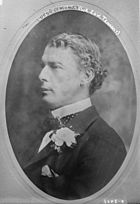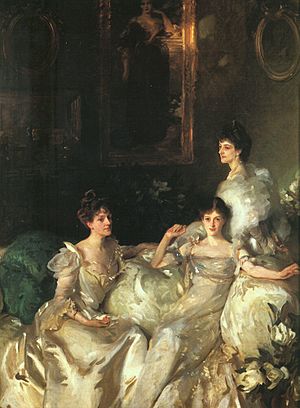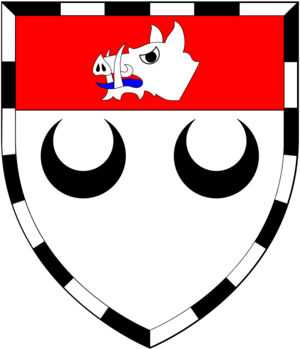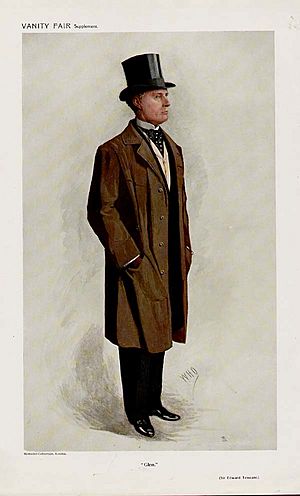Edward Tennant, 1st Baron Glenconner facts for kids
Quick facts for kids
The Lord Glenconner
|
|
|---|---|

Lord Glenconner, circa 1900
|
|
| Born | 31 May 1859 |
| Died | 21 November 1920 (aged 61) |
| Tenure | 1911–1920 |
| Spouse(s) | |
| Issue | Hon. Clare Tennant Hon. Edward Tennant Christopher Tennant, 2nd Baron Glenconner Hon. David Tennant Hon. Stephen Tennant |
| Parents | Sir Charles Tennant, 1st Baronet Emma Winsloe |
|
|
|
Edward Priaulx Tennant, also known as the 1st Baron Glenconner, was an important Scottish businessman and politician. He was born on May 31, 1859, and passed away on November 21, 1920. He started as Sir Edward Tennant, 2nd Baronet, in 1906. Later, in 1911, he was given the special title of Baron Glenconner. This made him a "peer," which is a member of the nobility.
Contents
His Family and Early Life
Edward was the oldest son of Sir Charles Tennant, who was the 1st Baronet. A Baronet is a special title that can be passed down in a family, like a knight but with a hereditary rank.
His brother was Harold Tennant, who was also a politician. His sister, Margot Tennant, married H. H. Asquith, who later became the Prime Minister of the United Kingdom. This means Edward was connected to a very important political family.
Edward went to famous schools like Eton College and Trinity College, Cambridge. After his studies, he traveled a lot. He visited places like Africa, India, and America.
His Career in Politics and Business
Edward Tennant worked as an Assistant Private Secretary for Sir George Otto Trevelyan. Sir George was in charge of Scottish affairs from 1892 to 1895.
Edward tried to become a Member of Parliament (MP) several times. He ran for election in Partick in 1892 and Peebles and Selkirk in 1900, but he didn't win those times.
However, in 1906, he was elected as an MP for Salisbury. He held this seat until 1910. In 1906, he also inherited his father's title, becoming the 2nd Baronet.
In 1911, he received the title of Baron Glenconner. This meant he became a member of the House of Lords, which is part of the UK Parliament.
Other Important Roles
Lord Glenconner held many other important positions:
- He was the Lord High Commissioner to the General Assembly of the Church of Scotland for several years (1911, 1912, 1913, and 1914). This role involved representing the King at the Church's main meeting.
- He served as the Lord Lieutenant of Peeblesshire from 1908 to 1920. A Lord Lieutenant is the King's personal representative in a county.
- He was the Chairman of the Union Bank of Scotland.
- He was a director for several companies, including the Mysore Gold Company.
- He led the Tharsis Sulphur and Copper Company, a large chemical works in Glasgow. This company was a big part of his family's wealth.
- He was also the President of the Scottish Modern Arts Association for a time.
- He was President of the National Association for the Prevention of Tuberculosis.
Edward Tennant was known for his good judgment and quick decisions in business. He was a very active person in both public life and his local community.
Giving Back to the Community
Edward Priaulx Tennant was a very generous person. He used his wealth to help others.
In 1914, he gave 13 acres of land in Glasgow to the city. This land was turned into a recreation ground for people to enjoy.
In 1918, he bought Dryburgh Abbey for a large sum of money. He then gave this historic abbey to the nation. This act helped save it from falling into private hands and possibly being ruined. His generosity inspired others to donate ancient monuments to Scotland.
His Homes and Art Collection
In 1900, Edward bought an estate called Wilsford cum Lake near Salisbury. He had a large mansion built there between 1904 and 1906.
He also updated his London home at 34 Queen Anne's Gate in 1910. He added an art gallery to display the many artworks he had inherited. What was special is that he created a separate entrance for the public. This allowed people to view his art collection on certain days, which was greatly appreciated.
His Family Life

In 1895, Edward married Pamela Wyndham. She was a writer and the sister of George Wyndham. They had several children together:
- Hon. Clarissa "Clare" Madeline Georgiana Felicite Tennant (1896–1960)
- Hon. Edward Wyndham Tennant (1897–1916), who became a war poet. Sadly, he passed away during World War I.
- Christopher Grey Tennant (1899–1983), who became the 2nd Baron Glenconner after his father.
- Hon. David Pax Tennant (1902–1968), who started a famous club in London called the Gargoyle Club.
- Hon. Stephen James Napier Tennant (1906–1987)
His Passing
Edward Priaulx Tennant passed away on November 21, 1920, due to heart failure. He was 61 years old. He was cremated, and his ashes were buried in Traquair, Peeblesshire. His son, Christopher Tennant, inherited his title and became the 2nd Baron Glenconner.



